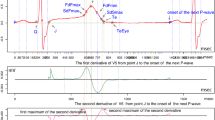Abstract.
The long QT syndrome is a congenital disease with frequent familial transmission, characterized primarily by prolongation of the QT interval and by the occurrence of life-threatening arrhythmias. The syndrome may be familial, with or without congenital deafness, or it may be idiopathic. We attempted to assess ventricular repolarization and to identify patients with the Jervell and Lange–Nielsen syndrome among 132 deaf–mute school children. Five deaf–mute subjects had Jervell and Lange–Nielsen syndrome. The deaf–mute subjects were divided into two subgroups according to the length of their QT intervals: group 1 included 5 cases with the long QT interval (>440 msec), and group 2 included 127 subjects with the normal QT interval (≤440 msec). Group 3 was composed of 96 control subjects. The mean QT, QTc, JT, and JTc intervals (418 ± 70, 500 ± 38, 302 ± 65, and 389 ± 36 msec, respectively) in group 1 were significantly longer than those of group 2 (344 ± 23, 408 ± 22, 249 ± 34, and 291 ± 28 msec, respectively) and group 3 (325 ± 11, 383 ± 26, 228 ± 36, and 269 ± 46 msec, respectively). The dispersion (d) values (QT-d, QTc-d, JT-d, and JTc-d; 63 ± 10, 73 ± 8, 60 ± 8, and 62 ± 11 msec, respectively) of group 1 were significantly longer than those of group 2 (49 ± 16, 43 ± 11, 48 ± 21, and 45 ± 18 msec, respectively) and group 3 (33 ± 13, 33 ± 14, 28 ± 16, and 27 ± 14 msec, respectively) at similar mean RR intervals. Also, the mean QT, QTc, JT, and JTc intervals and the dispersion values (QT-d, QTc-d, JT-d, and JTc-d) in group 2 were significantly longer than those of group 3 at similar mean RR intervals. Consequently, in this study, we determined that the deaf–mute children who did not meet the criteria for Jervell and Lange–Nielsen syndrome still had evidence of subtle derepolarization abnormalities evidenced by intermediate prolongation of QTc, JTc, and the corresponding measures of dispersion, and we believe an electrocardiogram examination of deaf–mute subjects will reveal this potentially life-threatening syndrome.
Similar content being viewed by others
Author information
Authors and Affiliations
Rights and permissions
About this article
Cite this article
Tuncer, C., Çokkeser, Y., Komsuoglu, B. et al. Assessment of Ventricular Repolarization in Deaf–Mute Children. Pediatr Cardiol 21, 135–140 (2000). https://doi.org/10.1007/s002469910021
Published:
Issue Date:
DOI: https://doi.org/10.1007/s002469910021




